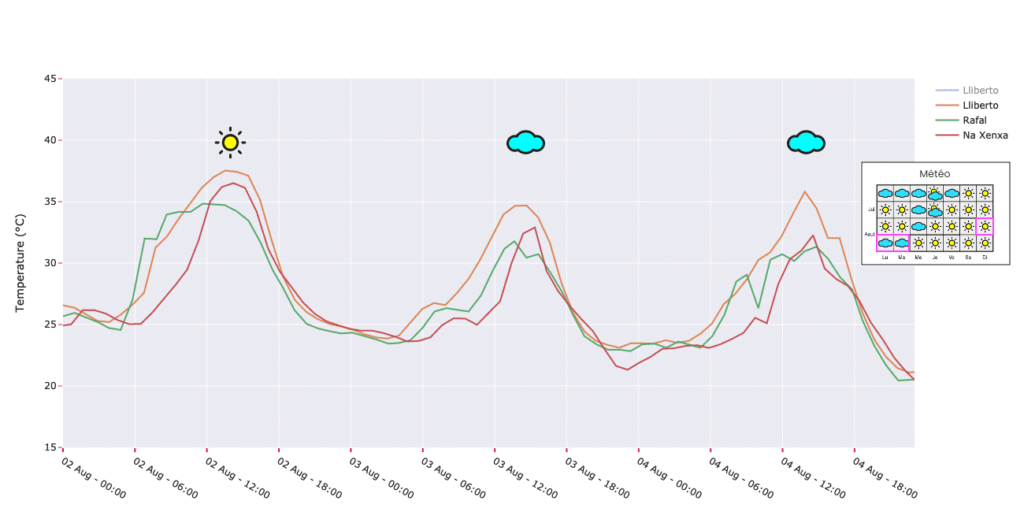The location of the apiary greatly conditions the development of future colonies. Bee health, productivity, feeding needs and various stresses are closely linked with the surrounding environment. Some beekeepers do not hesitate to affirm that the apiary location amounts up to 70% of beekeeping efforts.
While in a previous article we discussed the fundamentals for finding the best bee yard location, in the following lines we will conduct a detailed analysis of several existing apiary locations. To illustrate the topic, I will use an actual use-case we treated this summer. It unfolds on the island of Menorca in the Balearic Islands and concerns four apiaries on the eastern side of the island.

The story begins in the summer of 2020. During this period, we have observed frequent overheating in one of the apiaries. This has been materialized by alerts from Mellisphera jumping very regularly and for a large amount of hives.

It should be noted that when the brood reaches 38°C (100F) it is subjected to considerable stress. The bees do their best to cool down the enclosure by fetching water and bearding.

The duration of the episode as well as its frequency have an impact on the colony health and in particular on the brood development. Laboratory experiments have shown that brood raised under isothermal conditions at 38°C (100F) does not succeed in hatching any bees. At 37°C (98.6F) the birth rate is around 40%. Whereas for 35°C and 36°C (95 and 96,8F) the hatching rate is 100%.

These results are to be taken with care keeping in mind that these experiments were conducted at a constant temperature. In real life the temperature varies during the day and the week. A good assumption is to consider these laboratory experiments as an asymptotic case.
In our practical case in Menorca, the situation is clearly illustrated by the table below: Comparing this apiary with three other apiaries in the same area, we clearly notice that the incidence rate of overheating is by far the highest in the Lliberto apiary.

The odd think is that this apiary is the most sheltered of the four. It is exposed to the west, on a north-south oriented hillside. As a consequence, in summer the sun does not shine directly on the hives before 11am! And yet, it is the one showing the most important overheating alerts! 🤷♂️
These findings prompted us to deepen the analysis to better understand the situation. But before getting to the heart of the matter, it will be useful to introduce the three apiaries: Lliberto, Rafal and Na Xenxa to fully understand the characteristics of their locations.
Introducing the three apiaries
The three apiaries Lliberto, Rafal and Na Xenxa are less than 20km (12mi) from each other. The overall climate and the landscape can then be considered identical. Their differences in behavior are therefore mostly associated with the local conditions of the yard.

Lliberto is an apiary located on the west side of a north-south facing hillside, on an ancient road. It is surrounded by fairly dense woody vegetation (olive trees and other species) down and above the hill.
Rafal is south-facing on a slight promontory. The sun reaches it in the early morning until dusk. The vegetation is relatively low and the site is quite cleared.
Na Xenxa is placed in an old sandstone quarry, the limestone that was formerly used to build all the houses on the island. It is thus sunk about 3 meters in relation to the surface of the neighboring fields. Surrounded also by trees, it sees gets sunlight from the mid-morning.
Comparative analysis of the three sites
Based on these findings we initiated a study to understand the reasons for unexpected overheating. And specially to understand why the locations of the other apiaries were less affected than Lliberto.
All these apiaries are equipped with internal sensors (which revealed the overheating of the brood) but also external hivescales that also measure ambient temperature. Those ambient temperature measurements taken continuously throughout the season allowed us to shed light on this mystery.
Maximum temperatures of the apiary
First of all, we analyzed the daily maximum temperatures of the apiary. Lliberto has two hives equiped with scales. It is clear from the curves (orange and blue) that despite their respective deviation (related with the particular position of each hive) they are often higher than those of the two other apiaries (green and red).

On this graph we can also see a second phenomenon: The Rafal apiary, which is by far the most exposed to the sun, from morning to evening, also shows the minimum temperatures!
An apiary fully exposed to the summer sun experiences a lower ambient temperature than those that are supposed to be sheltered? We didn't expect it!
We continue to explore ...
Temperature profile according to the weather
We then looked at the details of each day. Here three consecutive days on August 2, 3 and 4th. They have the characteristic of having different sunshine. The first day was sunny while the two others were cloudy.

At this stage we start noticing an interesting phenomenon: Depending on the location of the apiary there is a difference between days with sun and days without. We are not referring here to the maximum values (it is normal they are higher under sunny conditions) but to the daily temperature distribution.
With sunshine, Rafal starts very early in the morning but falls quickly in the afternoon. Whereas Lliberto starts just as fast BUT it climbs much higher and goes down much later.
On days without sun, Lliberto starts squarely earlier than Rafal and also reaches higher peaks.
Temperatures during the day
Going to look in detail on a sunny day, here is the result. At 6am Rafal went up to 35°C (95F) while the others had to wait for 10am. On the other hand, Rafal will not go higher and will come down from 2pm. Lliberto and Na Xenxa will keep at almost 40°C (104F) during 5 hours, from 12 to 5 pm.
We now realize the extent of the problem : The alerts had shown the 38°C (100,4F) threshold was reached within the colony. However, the graphs also tell us that the overheating of the brood was maintained for several hours 🥵.

So finally, the explanation of this case can be found in the environment: Sheltered apiaries are also those with the least air circulation. They have an environment that soaks heat and gradually releases it throughout the day.
Rafal is located on the back of a valley with a slight slope on each side. Even if the sun strikes from morning to evening, the rugged yard induces some air circulation.
Lliberto is on a hillside, with a large mass of trees down and up-hill. This mass stores heat and releases it throughout the day, even on overcast days. The shelter of the hillside also limits draughts and the stagnant air mass heats up permanently.
Na Xenxa is located in an old quarry, slightly embedded in the limestone and sheltered by trees. Once again, this configuration favors the storage of energy by the environment and gradually releases it.
Lessons learned about the location of the apiary
With this analysis we have learned that sometimes actual effects can be quite counter-intuitive. Apiaries in the sun can manage the temperature better than those thought to be more sheltered. The environment close to the apiary plays an essential role in the circulation of air and the restitution of heat by the environment.
We were far from imagining those effects before measuring the behavior of the colonies. The alerts sent by the system made it possible to identify the problem and to evaluate the influential parameters. Cross-comparison with other apiaries was also of great help and offers interesting perspectives on how to evaluate a yard and its optimal layout.
Acknowledgements
Many thanks to Bernat Cardona, President of the Menorca Beekeepers' Association, and to Victor Borras, both of them careful beekeepers, without whom this work would not have been possible.

